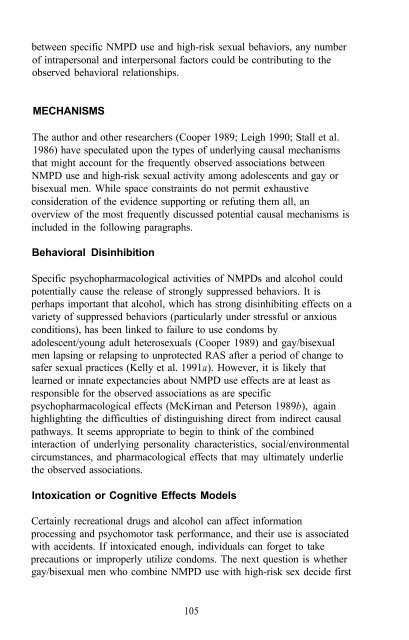The Context of HIV Risk Among Drug Users and Their Sexual Partners
The Context of HIV Risk Among Drug Users and Their Sexual Partners
The Context of HIV Risk Among Drug Users and Their Sexual Partners
Create successful ePaper yourself
Turn your PDF publications into a flip-book with our unique Google optimized e-Paper software.
etween specific NMPD use <strong>and</strong> high-risk sexual behaviors, any number<br />
<strong>of</strong> intrapersonal <strong>and</strong> interpersonal factors could be contributing to the<br />
observed behavioral relationships.<br />
MECHANISMS<br />
<strong>The</strong> author <strong>and</strong> other researchers (Cooper 1989; Leigh 1990; Stall et al.<br />
1986) have speculated upon the types <strong>of</strong> underlying causal mechanisms<br />
that might account for the frequently observed associations between<br />
NMPD use <strong>and</strong> high-risk sexual activity among adolescents <strong>and</strong> gay or<br />
bisexual men. While space constraints do not permit exhaustive<br />
consideration <strong>of</strong> the evidence supporting or refuting them all, an<br />
overview <strong>of</strong> the most frequently discussed potential causal mechanisms is<br />
included in the following paragraphs.<br />
Behavioral Disinhibition<br />
Specific psychopharmacological activities <strong>of</strong> NMPDs <strong>and</strong> alcohol could<br />
potentially cause the release <strong>of</strong> strongly suppressed behaviors. It is<br />
perhaps important that alcohol, which has strong disinhibiting effects on a<br />
variety <strong>of</strong> suppressed behaviors (particularly under stressful or anxious<br />
conditions), has been linked to failure to use condoms by<br />
adolescent/young adult heterosexuals (Cooper 1989) <strong>and</strong> gay/bisexual<br />
men lapsing or relapsing to unprotected RAS after a period <strong>of</strong> change to<br />
safer sexual practices (Kelly et al. 1991a). However, it is likely that<br />
learned or innate expectancies about NMPD use effects are at least as<br />
responsible for the observed associations as are specific<br />
psychopharmacological effects (McKirnan <strong>and</strong> Peterson 1989b), again<br />
highlighting the difficulties <strong>of</strong> distinguishing direct from indirect causal<br />
pathways. It seems appropriate to begin to think <strong>of</strong> the combined<br />
interaction <strong>of</strong> underlying personality characteristics, social/environmental<br />
circumstances, <strong>and</strong> pharmacological effects that may ultimately underlie<br />
the observed associations.<br />
Intoxication or Cognitive Effects Models<br />
Certainly recreational drugs <strong>and</strong> alcohol can affect information<br />
processing <strong>and</strong> psychomotor task performance, <strong>and</strong> their use is associated<br />
with accidents. If intoxicated enough, individuals can forget to take<br />
precautions or improperly utilize condoms. <strong>The</strong> next question is whether<br />
gay/bisexual men who combine NMPD use with high-risk sex decide first<br />
105
















